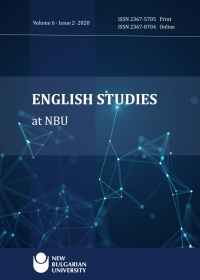Layered Temporalities - Between Modernism and Postmodernism - in Jhumpa Lahiri's The Lowland
DOI:
https://doi.org/10.33919/esnbu.20.2.5Keywords:
Circular time, Egoism, Linear time, Modernity, PostmodernismAbstract
The discussion approaches Jhumpa Lahiri's novel The Lowland, aiming to trace the author's positioning in relation to modern and postmodern assumptions. The argument follows the main character's (Gauri) transnational trajectory, as she crosses frontiers in a journey that also spans large temporal dimensions. Gauri's unconventional choices are to be interpreted in relation with her permanent interest in the nature of time that is also a part of her doctoral research in philosophy. Gauri's professional goals and her personal destiny appear strongly conditioned by the political context of her pre-emigration days, i.e. the Naxalite movement. All the above suggest that The Lowland can be read as a novel with an implied message about the grand narrative of history in relation to time perception and the possibility of (female) identity formation. Whether Lahiri's approach to these themes echoes a predominantly (post)modern outlook is the focus of the present analysis.
Downloads
Published
How to Cite
Issue
Section
License
Copyright (c) 2020 Adriana-Elena Stoican

This work is licensed under a Creative Commons Attribution-NonCommercial 4.0 International License.
All published articles in the ESNBU are licensed under the Creative Commons Attribution-NonCommercial 4.0 International License (CC BY-NC 4.0). This license lets others remix, tweak, and build upon your work non-commercially, and although their new works must also acknowledge you and be non-commercial, they don't have to license their derivative works on the same terms.
In other words, under the CC BY-NC 4.0 license users are free to:
Share - copy and redistribute the material in any medium or format
Adapt - remix, transform, and build upon the material
Under the following terms:
 Attribution (by) - All CC licenses require that others who use your work in any way must give you credit the way you request, but not in a way that suggests you endorse them or their use. If they want to use your work without giving you credit or for endorsement purposes, they must get your permission first.
Attribution (by) - All CC licenses require that others who use your work in any way must give you credit the way you request, but not in a way that suggests you endorse them or their use. If they want to use your work without giving you credit or for endorsement purposes, they must get your permission first. NonCommercial (nc) - You let others copy, distribute, display, perform, and modify and use your work for any purpose other than commercially unless they get your permission first.
NonCommercial (nc) - You let others copy, distribute, display, perform, and modify and use your work for any purpose other than commercially unless they get your permission first.
If the article is to be used for commercial purposes, we suggest authors be contacted by email.
If the law requires that the article be published in the public domain, authors will notify ESNBU at the time of submission, and in such cases the article shall be released under the Creative Commons 1 Public Domain Dedication waiver CC0 1.0 Universal.
Copyright
Copyright for articles published in ESNBU are retained by the authors, with first publication rights granted to the journal. Authors retain full publishing rights and are encouraged to upload their work to institutional repositories, social academic networking sites, etc. ESNBU is not responsible for subsequent uses of the work. It is the author's responsibility to bring an infringement action if so desired by the author.
Exceptions to copyright policy
Occasionally ESNBU may co-publish articles jointly with other publishers, and different licensing conditions may then apply.






